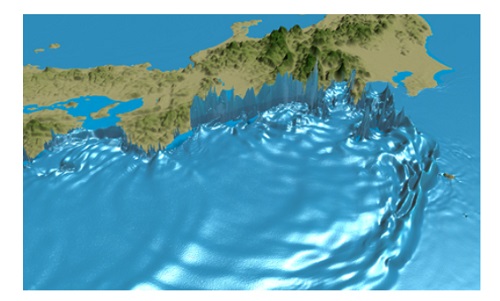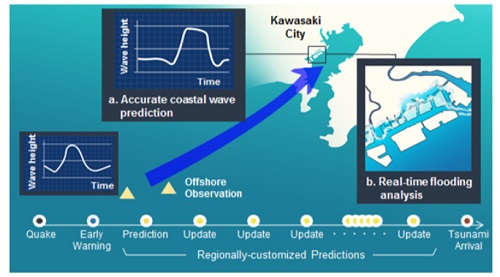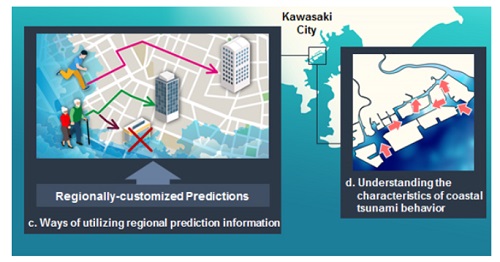|
Fujitsu in Joint Project Aiming for Tsunami Disaster Risk Reduction Using ICT in Kawasaki
TOKYO, Nov 24, 2017 - (JCN Newswire) - The Earthquake Research Institute at the University of Tokyo, the International Research Institute of Disaster Science (IRIDeS) at Tohoku University, the City of Kawasaki, and Fujitsu Limited have today signed a memorandum determining that they will collaborate on a project that advances the utilization of disaster prevention technologies and ICT, including artificial intelligence (AI) and supercomputers. The organizations will investigate technologies to predict tsunamis and take preemptive measures aimed at mitigating tsunami disaster risk in the Kawasaki coastal zone.
 | | Figure 1: Tsunami simulation for a major earthquake in the Nankai Trough(3) |
 | | Figure 2: Regionally customized tsunami predictions |
 | | Figure 3: Regionally customized preemptive measures for tsunamis |
The City of Kawasaki and Fujitsu signed a framework agreement aimed at promoting a sustainable community(1) in fiscal 2014, and this technology study is a part of those efforts, in collaboration with the Earthquake Research Institute and IRIDeS. In the future, the four organizations will also extend the results of this study from the coastal areas near Kawasaki to other regions, such as areas bordering the Nankai Trough, with the goal of contributing to the creation of sustainable communities that stand up well to disasters.
Details of the tsunami disaster mitigation technology study will be introduced at the inaugural World Bosai Forum International Disaster and Risk Conference 2017(2), which will be held in Sendai, Miyagi Prefecture on November 25-28, 2017.
Background
Since the Great East Japan Earthquake of 2011, Japan has rolled out infrastructure for offshore tsunami observations, and this infrastructure is being put to use to advance the development of a broad range of tsunami prediction methods. In Japan, with its diverse topographical features, there are significant differences among each region with regard to the degree of tsunami risk and level of urgency for evacuations in the case of a tsunami, and moreover, with the degree of difficulty in predicting tsunamis. For example, with a major earthquake in the Nankai Trough (figure 1), it is anticipated that there will be regions where a tsunami would hit within minutes following an earthquake, while it may take over an hour to reach Kawasaki or other parts inside Tokyo Bay. In order to more effectively implement measures to reduce disaster risk from a major tsunami that could occur in the future, a system needs to not only utilize tsunami predictions that look at the whole country, but also require regionally customized tsunami predictions that take into account the characteristics of each region.
With this in mind, these organizations have agreed to work toward the investigation of practical and effective tsunami disaster mitigation measures tailored to the characteristics and needs of each region by taking full advantage of the latest ICT, such as with AI and supercomputers, in a collaborative framework of industry, government and academia.
http://www.acnnewswire.com/topimg/Low_FujitsuTsunami112417Fig1.jpg
Figure 1: Tsunami simulation for a major earthquake in the Nankai Trough(3)
Details of the Initiative
With the Kawasaki coastal zone as an area of focus, the organizations, including the Emergency Management Office of the City of Kawasaki, are exchanging views and conducting a study of technology that will be effective where disasters occur. In light of an earthquake and tsunami threat as envisaged by the Earthquake Research Institute, the companies will utilize fast and accurate tsunami flooding simulation technology(4) jointly developed by IRIDeS and Fujitsu Laboratories Ltd., and the tsunami evacuation simulation technology that models evacuation behavior, which is advanced by IRIDeS and the Fujitsu Research Institute. The organizations plan to primarily consider the following four areas.
a. Increasing the accuracy of predictions of wave profile at the coast
The organizations will study methods for accurately predicting the profile of a tsunami hitting the Kawasaki coastal zone, including wave height and arrival time, using progressively obtained observational data from distant offshore tsunami observation stations, studying their effectiveness in light of a variety of hypothetical earthquakes (figure 2).
b. Real-time flooding analysis
The organizations will build a simulation model to analyze tsunami flooding for the Kawasaki coastal zone at high resolution in real time, based on offshore observational data (figure 2).
c. Ways of utilizing regional prediction information
The organizations will evaluate the effect of disaster mitigation gained by using the regional tsunami prediction information described in a. and b. based on a simulation that models human behavior, investigating effective methods for how to utilize this information in advance (figure 3).
d. Understanding the characteristics of coastal tsunami behavior
The organizations will work to gain a preemptive understanding of the complex behavior of a tsunami in the Kawasaki coastal zone, which has multiple man-made waterways, using simulations of a variety of possible tsunamis (figure 3).
http://www.acnnewswire.com/topimg/Low_FujitsuTsunami112417Fig2.jpg
Figure 2: Regionally customized tsunami predictions
http://www.acnnewswire.com/topimg/Low_FujitsuTsunami112417Fig3.jpg
Figure 3: Regionally customized preemptive measures for tsunamis
Future Plans
After conducting this technology study, the four organizations plan to consider issues including the uncertainty of predictions and consistency with tsunami early warning information from other organizations, with an eye towards the practical application of these technologies. Furthermore, they will contribute to the creation of effective regional disaster mitigation measures for possible future earthquakes and tsunamis by applying the results of this technology study of the Kawasaki coastal zone to other regions in the future, such as the Nankai Trough coastal region.
(1) Framework agreement aimed at promoting a sustainable community
Kawasaki City and Fujitsu Sign Framework Agreement (press release, February 19, 2014) http://www.fujitsu.com/global/about/resources/news/press-releases/2014/0219-01.html
(2) World Bosai Forum International Disaster and Risk Conference 2017
http://www.worldbosaiforum.com/english/
(3) Tsunami simulation for a major earthquake in the Nankai Trough
Data from the Cabinet Office Investigative Commission on Modeling a Major Earthquake in the Nankai Trough was used for the simulation.
(4) Tsunami flooding simulation technology
Tohoku University and Fujitsu Succeed in Real-Time Flood Analysis Using Supercomputer-Based High-Resolution Tsunami Modeling (press release, February 27, 2015) http://www.fujitsu.com/global/about/resources/news/press-releases/2015/0227-02.html
Contact:Fujitsu Limited
Public and Investor Relations
Tel: +81-3-6252-2176
URL: www.fujitsu.com/global/news/contacts/
Source: Fujitsu Ltd
Sectors: Cloud & Enterprise
Copyright ©2024 JCN Newswire. All rights reserved. A division of Japan Corporate News Network. |
Latest Release

JCB enables JCB Contactless acceptance at Taichung MRT in Taiwan
Apr 26, 2024 10:00 JST
| 
Mazda Production and Sales Results for March 2024 and for April 2023 through March 2024
Apr 25, 2024 18:21 JST
| 
MHI Begins Operation of SOEC Test Module the Next-Generation High-Efficiency Hydrogen Production Technology at Takasago Hydrogen Park
Apr 25, 2024 17:45 JST
| 
GAC Honda to Begin Sales of All-new e:NP2, the Second Model of e:N Series
Apr 25, 2024 16:50 JST
| 
Toyota Exhibiting at Beijing Motor Show 2024
Apr 25, 2024 16:25 JST
| 
Honda Reaches Basic Agreement with Asahi Kasei on Collaboration for Production of Battery Separators for Automotive Batteries in Canada
Apr 25, 2024 11:10 JST
| 
UNIQLO Sponsors KAWS + Warhol Exhibition Tour, Starting in Pittsburgh
Apr 25, 2024 09:00 JST
| 
Mitsubishi Power Begins Commercial Operation of Seventh M701JAC Gas Turbine in Thailand GTCC Project; Achieves 75,000 AOH To-Date
Apr 24, 2024 17:19 JST
| 
MC and Denka Sign J/V Agreement in Fullerene Business
Apr 24, 2024 17:02 JST
| 
Mitsubishi Motors Posts Record Sales in the Philippines in FY2023
Apr 24, 2024 13:56 JST
| 
NEC Develops High-speed Generative AI Large Language Models (LLM) with World-class Performance
Apr 24, 2024 13:25 JST
| 
Fujitsu SX Survey reveals key success factors for sustainability
Apr 23, 2024 10:25 JST
| 
Fujitsu and METRON collaborate to drive ESG success: slashing energy costs, boosting productivity with new manufacturing industry solutions
Apr 22, 2024 16:09 JST
| 
NEC Strengthens Commitment to Space Industry with Investment in Seraphim Space Venture Fund II
Apr 22, 2024 15:09 JST
| 
Soft Space Launches the First and Only JCB Payment Gateway in Malaysia
Apr 22, 2024 15:00 JST
| 
TOYOTA GAZOO Racing takes a one-two in Croatian thriller
Apr 22, 2024 10:47 JST
| 
First-ever Mazda CX-80 Crossover SUV Unveiled in Europe
Apr 19, 2024 13:50 JST
| 
Fujitsu develops technology to convert corporate digital identity credentials, enabling participation of non-European companies in European data spaces
Apr 19, 2024 10:17 JST
| 
Mitsubishi Heavy Industries and NGK to Jointly Develop Hydrogen Purification System from Ammonia Cracking Gas
Apr 18, 2024 17:01 JST
| 
Toyota Launches All-New Land Cruiser "250" Series in Japan
Apr 18, 2024 13:39 JST
|
More Latest Release >>
|